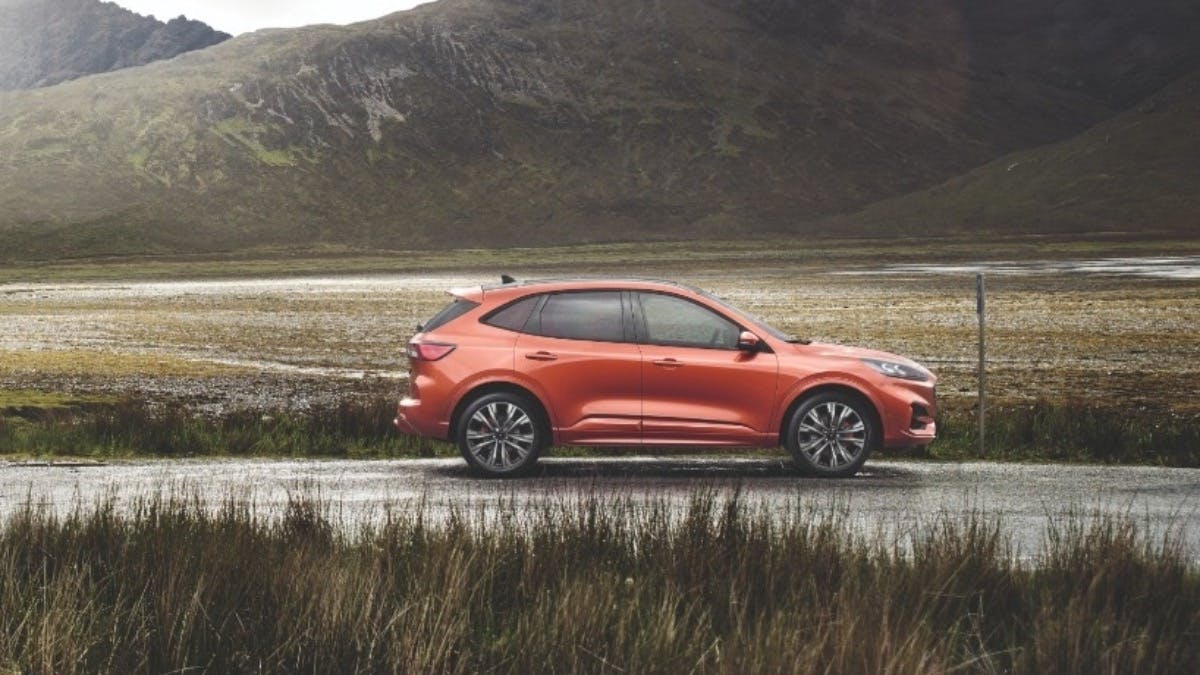All-New Ford Kuga goes almost 30 per cent further on a litre of fuel

The all-new Kuga SUV will deliver best-in-class fuel efficiency, with the range average improved by up to 28 per cent like-for-like.
-
All-new Kuga is Ford’s most electrified vehicle ever
The all-new Kuga is Ford’s most electrified vehicle ever, and the first to offer mild-, full- and plug-in hybrid powertrain technologies. Advanced powertrains are supported by enhanced aerodynamics and weight-saving measures.
Plug-in hybrid technology for Kuga helps deliver the best fuel efficiency, CO2 emissions and pure-electric driving range of any mid-size SUV, with the ability to cover 72 km in zero-emission driving mode (NEDC).
Comparing individual all-new Kuga powertrains with their equivalent output and configuration powertrains from the outgoing range delivers fuel efficiency improvements of up to 28 per cent (NEDC).* Including the all-new Kuga Plug-In Hybrid with zero-emission, pure-electric driving capability, the range average fuel efficiency is improved by 31 per cent.
The Kuga Plug-In Hybrid and Kuga EcoBlue Hybrid (48-volt mild hybrid) introduce electrified powertrains to Kuga for the first time and are available from launch later this year. The Kuga Hybrid self-charging full hybrid will follow soon after. Sophisticated Ford EcoBlue diesel and EcoBoost petrol engines are also available.
Efficiency designed-in
The all-new Kuga is the first SUV to be based on Ford’s new global front-wheel drive flexible architecture that supports improved aerodynamics for better fuel efficiency and reduces weight versus outgoing models by up to 80 kg when comparing equivalent powertrain variants.
Extensive use of aluminium has saved weight throughout the Kuga structure, including aluminium suspension control arms saving 6.8 kg, a composite-aluminium bumper beam saving 6.1 kg and a lighter braking system saving 0.8 kg.
Further weight savings include lighter carpets, hollow shock absorbers and even neodymium speakers in the audio system.
Aerodynamic efficiency is improved compared to the outgoing model even with an increase in overall dimensions. Optimised underbody shielding, door seals and flush-mounted roof rails all contribute to a drag reduction of almost 4 per cent.
Diverse powertrain line-up
Kuga Plug-In Hybrid:
- Combines a 2.5-litre Atkinson-cycle engine, an electric motor and generator with a 14.4 kWh lithium-ion battery.
- The battery can be charged using a front fender-mounted charging port and is automatically replenished on the move using regenerative charging technology that captures kinetic energy normally lost during braking.
- Drivers can choose when and how to deploy battery power using EV Auto, EV Now, EV Later and EV Charge modes. When the battery reaches its lowest state-of-charge, the Kuga automatically reverts to EV Auto mode – supplementing petrol engine power with electric motor assistance using recaptured energy for optimised fuel efficiency.
Kuga EcoBlue Hybrid:
- Enhances Ford’s 150 PS 2.0?litre EcoBlue diesel engine with 48-volt mild-hybrid technology.
- A belt-driven integrated starter/generator (BISG) replaces the standard alternator, enabling recovery of energy during vehicle decelerations, and charging a 48-volt lithium-ion air-cooled battery pack.
- The BISG also acts as a motor, using the stored energy to provide electric torque assistance to the engine under normal driving and acceleration, as well as running the vehicle’s electrical ancillaries. The 48-volt system enables Kuga’s Auto Start-Stop technology to operate in more situations for additional fuel savings.
Kuga EcoBoost:
- Available in 120 PS and 150 PS forms, Ford’s 1.5-litre EcoBoost petrol engine features Ford’s industry-first cylinder deactivation system for a three-cylinder engine, allowing one cylinder to be deactivated under light engine loads.
Kuga EcoBlue:
- 190 PS 2.0?litre EcoBlue and 120 PS 1.5?litre EcoBlue diesel engines both optimise fuel efficiency and emissions with features including high-pressure fuel injection and an integrated intake manifold.
Kuga Hybrid:
- Arriving later this year, uses a self-charging full hybrid powertrain that enables pure-electric driving capability and combines a 2.5-litre Atkinson cycle petrol engine, electric motor, generator; lithium-ion battery, and a Ford-developed power-split automatic transmission.
Ford is promising to electrify all future passenger vehicles coming to market and will introduce 18 electrified vehicles in Europe before the end of next year.Class-leading efficiency
- Kuga Plug-In Hybrid delivers from 1.2 l/100 km fuel efficiency and CO2 emissions from 26 g/km NEDC (from 1.4 l/100 km and 32 g/km WLTP) with pure-electric driving range of 72 km NEDC (56 km WLTP).
- Kuga EcoBlue Hybrid delivers from 4.3 l/100 km fuel efficiency and CO2 from 111 g/km NEDC (from 5.0 l/100 km and 132 g/km WLTP).
- Kuga 1.5-litre EcoBoost delivers from 5.5 l/100 km fuel efficiency and CO2 from 125 g/km NEDC (from 6.6 l/100 km and 150 g/km WLTP).
- Kuga 1.5-litre EcoBlue diesel delivers from 4.2 l/100 km fuel efficiency and CO2 from 109 g/km NEDC (from 5.1 l/100 km and 133 g/km WLTP).
- Kuga 2.0-litre EcoBlue diesel delivers from 4.8 l/100 km fuel efficiency and CO2 from 127 g/km NEDC (from 5.9 l/100 km and 155 g/km WLTP).
*Comparing 2019 Kuga 120 PS 2.0-litre TDCi six-speed automatic and 2020 Kuga 120 PS 1.5-litre EcoBlue eight-speed automatic.
The declared fuel/energy consumptions, CO2-emissions and electric range are determined according to the technical requirements and specifications of the European Regulations (EC) 715/2007 and (EU) 2017/1151 as last amended. Light Duty Vehicle type-approved using the World Harmonised Light Vehicle Test Procedure (WLTP) will have fuel/energy consumption and CO2-emission information for New European Drive Cycle (NEDC) and WLTP. WLTP will fully replace the NEDC latest by the end of the year 2020. The applied standard test procedures enable comparison between different vehicle types and different manufacturers. During NEDC phase-out, WLTP fuel consumption and CO2 emissions are being correlated back to NEDC. There will be some variance to the previous fuel economy and emissions as some elements of the tests have altered, so the same car might have different fuel consumption and CO2 emissions






